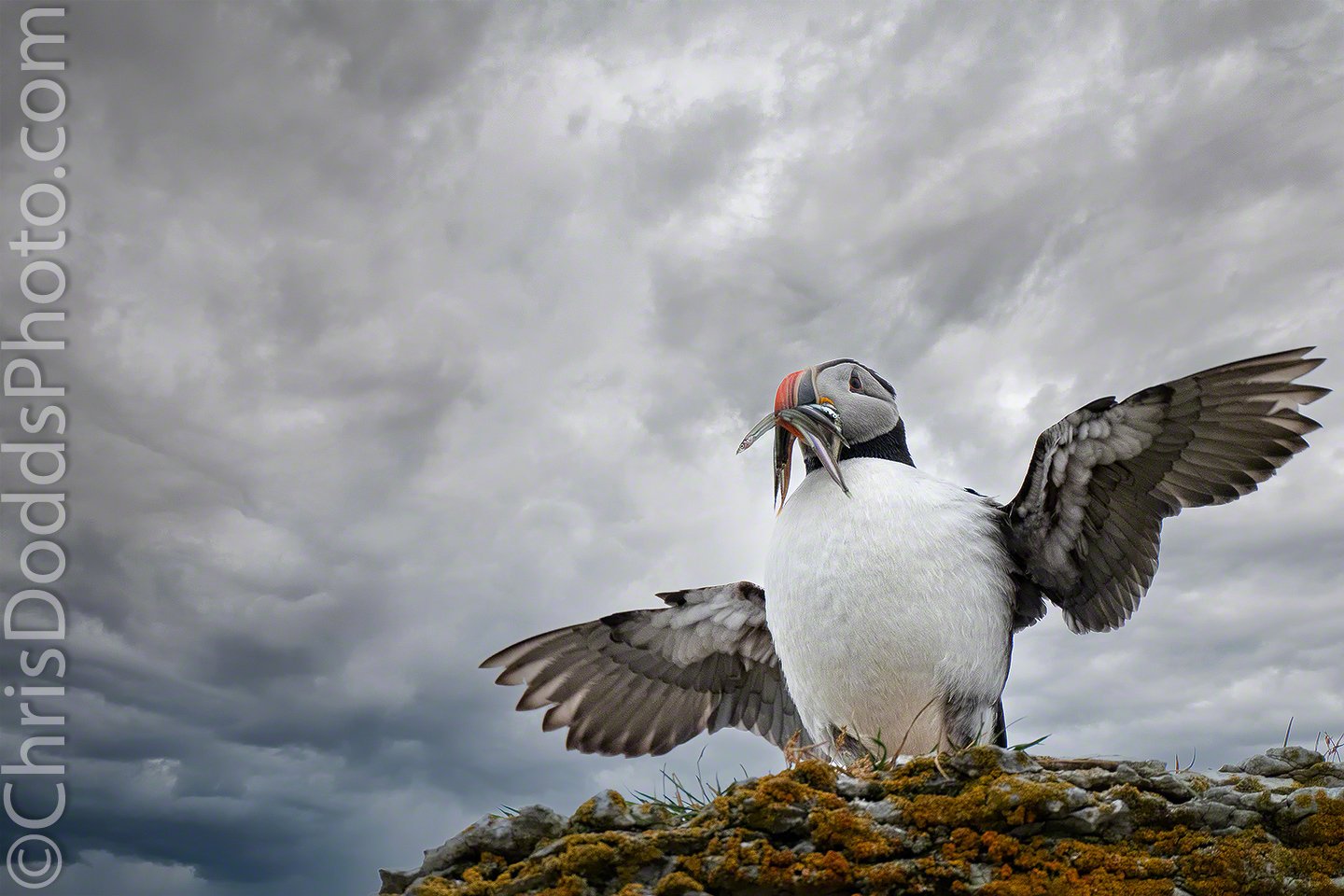DREAM OF PUFFINS…
I have been in search of the ultimate destination for an Atlantic Puffin workshop/safari for a very long time. The mandate was simple; find a location that is within reach, safe and easy to get to without a dangerous boat landing on slippery rocks and a place where we can get close to these comical little seabirds without hauling our gear up, and over, huge distances or having to hang over towering cliffs; a place where anyone can comfortably reach, regardless of age or physical ability; a place with reliable, safe and easy boat landings. I have photographed Atlantic Puffins in Iceland, England, Scotland, Wales, Maine, Newfoundland, New Brunswick and Quebec; All of these "known" places have their drawbacks., and I simply can't imagine subjecting my clients to the abuse. Mission accomplished; I have found Puffin Paradise. This is the very best place in the world to photograph Atlantic Puffins and Razorbills fishing, with fish in their bills, in-flight and in golden light.
Beyond the 50th parallel, along the North Shore of the Gulf of St. Lawrence, lies a remarkably beautiful scattering of some thirty limestone islands and more than 1000 granitic islets and reefs. The territory, the "Mingan Archipelago", became Mingan Archipelago National Park Reserve of Canada 1984.
This necklace of land carved out of the limestone bedrock is the site of spectacular natural monuments that bear witness to the never-ending wear of the sea and the centuries. And there is an abundance of life in this strange half-world: plants of variegated hues and shapes, seabirds gathered in colonies, seals, dolphins and whales, swarming the blue vastness in which the islands bathe.
Many of my favourite images of Puffins and Razorbills were made with only my Sony a9 and Sony 100-400mm f/4.5-5.6 G Master lens! The Puffins and Razorbills and plentiful and they fly within inches of us. There will be many opportunities to photograph the Puffins and Razorbills returning to their burrows with fish in their mouths!
Join me, Canadian Wildlife Photographer Christopher Dodds, for a dream Puffin photography workshop/safari. This trip will be limited to 5-8 participants and will surely be the trip of a lifetime for anyone seeking to get close and personal (safely) to Atlantic Puffins and Razorbills. We will be the only inhabitants of the island; we will be sleeping within 50 feet of the nesting Puffins and Razorbills! Gourmet meals included! Dawn to dusk Puffin photography.
Our target subjects include (but are not limited to): Atlantic Puffin, Razorbill, Common Murre, Savannah Sparrow, Semipalmated Plover, Semipalmated Sandpiper, White-rumped Sandpiper, Black Guillemot, Common Eider, Great Cormorants, Black-backed Gull, Herring Gull, Grey Seal, Minke Whale many other species of birds and marine mammals.
The trips are timed to coincide with the very best time to be at the colony with the Puffins returning with fish to feed their young.
Includes: Four days of professional instruction and guidance by Christopher Dodds, boat transportation to and from the island, three nights of single occupancy accommodation, gourmet meals, non-alcoholic beverages, and logistics management. Not included in the price is your transportation to Montreal Pierre-Elliot Trudeau Airport (YUL), hotels (I have a block of discounted rooms available at the Montreal Airport Marriott for nights before & after the workshop), meals, drinks, souvenirs or other expenses of a personal nature.
Who should attend: This workshop is highly recommended for any level photographer. Whether you are completely new to nature photography, an experienced amateur, or a seasoned pro. There will be something to photograph and we will have plenty of time to tailor your instruction to your abilities. The seasoned pro can take full advantage of the logistics, my site and subject knowledge.
Getting there: The starting point and meeting place is the town of Longue-Pointe-de-Mingan, Quebec (Canada). You should arrive in Sept-Iles, Quebec the day before your workshop starts.
Sept-Iles Airport (airport code: YZV serviced by Air Canada) is 152km or 94.5 miles from Lounge-Pointe-de-Mingan.
Quebec City Jean Lesage Airport (Airport code: TQB Serviced by most carriers) is 831km or 516 miles from Longue-Pointe-de-Mingan.
Montreal Pierre Elliott Trudeau Airport (Airport code: YUL Serviced by most carriers) is 1,086km or 675 miles from Longue-Pointe-de-Mingan.
Details: An extremely detailed email with the precise itinerary, hotel recommendations (for the night before your workshop), camera gear suggestions and tested clothing checklist will be emailed after registration is complete.
Questions: Feel free to email me at chris@chrisdoddsphoto.com or call me at +1 (514) 945-6195























